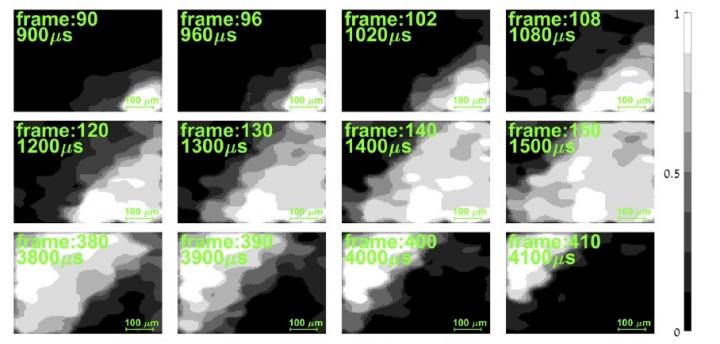Ghost imaging approach could enable detailed movies of the heart with low-dose x-rays

Credit: Sharon Shwartz, Bar-Ilan University
WASHINGTON — Researchers have demonstrated a new high-resolution x-ray imaging technique that can capture the motion of rapidly moving objects and quickly changing dynamics. The new method could be used for non-destructive imaging of moving mechanical components and to capture biological processes not previously available with medical x-ray imaging.
“The technique we demonstrated can be used with any x-ray source, plus it is low cost, simple and robust,” said research team leader Sharon Shwartz from Bar-Ilan University in Israel. “Thus, it opens up the possibility of using x-rays to measure fast dynamics outside the lab.”
In The Optical Society (OSA) journal Optics Express, the researchers describe their new x-ray imaging approach, which uses a non-traditional imaging method known as ghost imaging to achieve fast imaging speeds with high spatial resolution. They demonstrate the technique by creating an x-ray movie of a blade rotating at 100,000 frames per second.
“Medical imaging systems based on this technique could offer a new diagnostic tool for physicians,” said Shwartz. “Our approach could, for example, be used to acquire high-resolution movies of the heart while greatly reducing the radiation dose for patients.”
Seeing through surfaces
X-rays are useful for imaging because of their unique capability to penetrate surfaces that are opaque to visible wavelengths. Traditional x-ray imaging typically uses a pixelated camera with each pixel measuring the intensity level of the x-ray beam at a specific position.
Capturing higher resolution x-ray images requires more pixels, which, in turn, creates huge amounts of data that take time to transfer. This creates a trade-off between imaging speed and spatial resolution that makes it impossible to capture high-speed events with high resolution. Although very specialized techniques involving extremely powerful x-rays can overcome this trade-off, these x-ray sources are only available at large synchrotrons found at a few facilities around the world.
In the new work, the researchers turned to ghost imaging because it uses single-pixel detectors that can improve the imaging speed. Ghost imaging works by correlating two beams — in this case, X-ray beams — that do not individually carry any meaningful information about the object. One beam encodes a random pattern that acts as a reference and never directly probes the sample. The other beam passes through the sample. Because very little x-ray power comes into contact with the object being imaged, ghost imaging can also help reduce x-ray exposure when used for medical imaging.
“Although single-pixel detectors can be much faster than pixelated detectors, they do not provide the spatial resolution necessary for image reconstruction,” said Shwartz. “We used ghost imaging to overcome this problem and showed that we can image fast dynamics with spatial resolution comparable to or even better than the state-of-the-art x-ray pixelated detectors.”
A simple solution
To create the reference beam needed for ghost imaging, the researchers used standard sandpaper mounted on motorized stages to create a random pattern that was recorded with a high-resolution, slow framerate pixelated x-ray camera. As the stage was moved to each position, the x-ray beam hit a different area of the sandpaper, creating random x-ray transmissions, or intensity fluctuations.
They then removed the pixelated camera from the x-ray beam and inserted the object to be imaged and a single-pixel detector. They moved the motorized stages to irradiate the object with the intensity fluctuation patterns introduced at the various positions of the sandpaper and then measured the total intensity after the beam hit the object by using the single-pixel detector.
To use this approach to image a fast-moving blade, the researchers synchronized the measurements with the blade’s movement. A final image could then be reconstructed by correlating the reference pattern with the intensity measured by the single-pixel detector for each position of the blade.
The researchers created a movie of the moving blade by performing image reconstruction frame-by-frame to capture the blade at different positions. The resulting movie clearly shows the motion with a spatial resolution of about 40 microns — nearly an order of magnitude better than the resolution of currently available medical imaging systems.
The researchers are continuing to make improvements to the overall system as well as the image reconstruction algorithm to improve resolution and shorten measurement times.
###
Paper: O. Sefi, Y. Klein, E. Strizhevsky, I.P. Dolbnya, S. Shwartz, X-ray imaging of fast dynamics with single-pixel detector, Opt. Express, 28, 17, 24568-24576 (2020).
DOI: https:/
About Optics Express
Optics Express reports on scientific and technology innovations in all aspects of optics and photonics. The bi-weekly journal provides rapid publication of original, peer-reviewed papers. It is published by The Optical Society (OSA) and led by Editor-in-Chief James Leger of the University of Minnesota, USA. Optics Express is an open-access journal and is available at no cost to readers online at OSA Publishing.
About The Optical Society
Founded in 1916, The Optical Society (OSA) is the leading professional organization for scientists, engineers, students and business leaders who fuel discoveries, shape real-life applications and accelerate achievements in the science of light. Through world-renowned publications, meetings and membership initiatives, OSA provides quality research, inspired interactions and dedicated resources for its extensive global network of optics and photonics experts. For more information, visit osa.org.
Media Contact: [email protected]
Media Contact
James Merrick
[email protected]
Original Source
https:/
Related Journal Article
http://dx.




